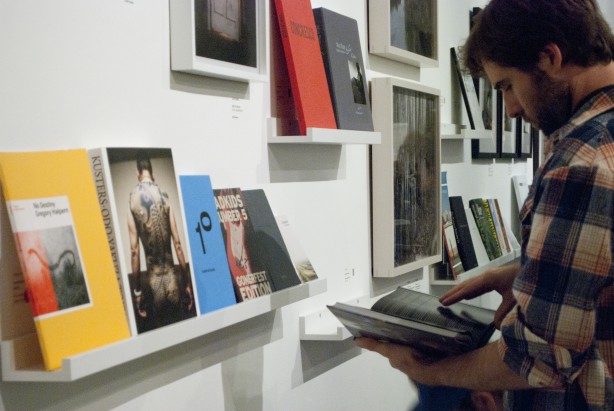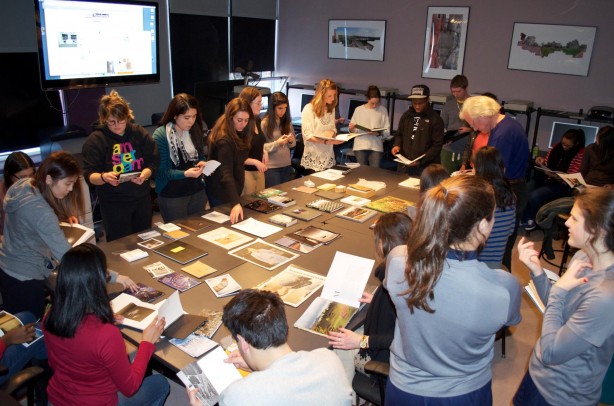Interview by Tom Griggs
What is the backstory on how the iPL formed? What gave you the drive to create a photography book library?
Larissa Leclair: I started off as a photographer, but my interest in archives began in graduate school, when I spent most of my time researching and working in Manuscripts & Archives at Yale University with photographs, postcards, ephemera and books. I came to understand the life of objects and the role of an archive – both its strengths and its pitfalls. While there, I was a member of the Photographic Memory Workshops and continue to be part of it now, ten years later. Each year the PMW and the Beinecke Rare Book and Manuscript Library team up to present a Master Class. Graduate students and scholars are given the opportunity to spend a day (or two, or four) with an entire collection from the Western Americana Collection at the Beinecke, along with the photographer of the collection or expert scholars on the collection.
The Master Class in April of 2010, that I attended, focused on the Peter Palmquist Collection. Peter Palmquist’s life mission after retiring was very inspiring and his collection has and will have a big impact on the history of photography specifically relating to women in photography since the late 1800’s. It will enable photo historians to fill in the gender gaps. The vision encapsulated in his collection, and the fact that he had done it on his own, was the final piece of encouragement I needed.
 The idea of creating a non-circulating library has been in my head for many years. It was an idea I wanted to bring to the table for a non-profit organization and at that time my focus was a broad range of international titles and making them available to a U.S. audience. That initiative never materialized but the idea stayed and evolved. Starting in 2009, with the rise of self-published books and the Blurb Photography Book Now competition, I was personally frustrated with not being able to view most of these books in person. So the idea of wishing for a central place to look at these kinds of books was in my head on the day I saw Peter Palmquist’s archive. I was blown away that a single individual could follow his passion, and create a collection without institutional support, and in the process have an impact on the history of photography. I realized I was not only interested in promoting indie published books, but most importantly, interested in creating a lasting archive. So two weeks after the Master Class – with the idea, one photobook, and a facebook page – I founded the Indie Photobook Library in May of 2010.
The idea of creating a non-circulating library has been in my head for many years. It was an idea I wanted to bring to the table for a non-profit organization and at that time my focus was a broad range of international titles and making them available to a U.S. audience. That initiative never materialized but the idea stayed and evolved. Starting in 2009, with the rise of self-published books and the Blurb Photography Book Now competition, I was personally frustrated with not being able to view most of these books in person. So the idea of wishing for a central place to look at these kinds of books was in my head on the day I saw Peter Palmquist’s archive. I was blown away that a single individual could follow his passion, and create a collection without institutional support, and in the process have an impact on the history of photography. I realized I was not only interested in promoting indie published books, but most importantly, interested in creating a lasting archive. So two weeks after the Master Class – with the idea, one photobook, and a facebook page – I founded the Indie Photobook Library in May of 2010.
In the last two and a half years of the iPL’s history, I have organized 20 pop-up library spaces and feature-length photobook exhibitions from the iPL archive, lectured at conferences and universities, been a consultant for other photobook exhibitions, and written about photobooks. The goals of the Indie Photobook Library are twofold: to showcase independent and self-published photobooks to be seen in person now (not just on the web) and to preserve them for future generations. The concept is a browse-able archive or non-circulating public library and the iPL has already become a benchmark collection in such a short time. Having a specific collection dedicated to these kinds of books allows for the development of future discourse on trends in self-publishing, the ability to reflect on and compare books in the collection, and for scholarly research to be conducted in years, decades and centuries to come.
Share with us a short history of the photobook. When did it begin to evolve as a vehicle for art photographers and what are some of the landmarks of its subsequent history?
LL: Since the beginning of the photographic medium with Fox Talbot’s The Pencil of Nature, the book has been an integral part of the history of photography; a part that has been substantiated and can easily be read about in Martin Parr and Gerry Badger’s The Photobook: A History. Volume 3 will be coming out soon. So the history of the photobook is as long as the history of photography itself. Anna Atkins, Francis Frith, Julia Margaret Cameron, Alexander Gardner were all putting their work into books. There was Muybridge; Japanese photobooks from the 1960’s and 70’s; Ed Ruscha; punk zines; and now this explosion with self-publishing and collaborative and independent small presses. That is egregiously abbreviated. There is so much to discuss! Yet even the photobooks covered in Parr and Badger is just a starting point. When I teach the history of photography, I discuss subjective history and offer parallel “histories” of the medium. I look forward to a truly inclusive “world” history of photography. And when I lecture about photobooks, I stress to the audience to make sure history remembers you by putting at least one copy of your photobook in a public collection. There is never a definitive history and it is always being written. And the Indie Photobook Library is playing a role in collecting photobook history today as it is happening and influencing what should be included in its ongoing history.

Lots of people have commented over the past few years that we’re in a photobook Golden Age. Do you think this is true? If so, what are the dynamics that would define this as a Golden Age?
LL: As online and print media are talking about the disappearance of the paper book form, the photography community is embracing the physical book. We indeed are seeing a renaissance, or Golden Age, for self-published and independently published books. The e-book world is having little effect on the DIY photobook culture. In my lecture at the New York Art Book Fair at MoMA PS1 in 2011, I categorized this current photobook movement as a second wave of self-publishing. The bookmakers of today continue the trail paved by those who challenged the paradigm in the 60’s and 70’s. Advances in digital printing and the option of POD in the last decade has greatly impacted the proliferation of self-published photobooks and has broken down barriers in thought and production for photographers wanting to put out their own book. The traditional publishing paradigm is being challenged. The mindset has changed. It can be done on your own!
What do you believe are the strengths and inherent limitations of the photobook format, as opposed to showing photographs on a wall or in a digital or multi-media format?
LL: Moholy-Nagy believed that the book form was the ideal format for photography. It is my preferred way of looking, revisiting, and owning work. Ruscha argued about his own work that the subject matter on the surface may not be that interesting, but once collected, compiled, and sequenced in book form, the package becomes something entirely different. The photobook can be as much an artistic object as the work inside and is a valid venue for viewing photography. Often the book form is the paramount space for a particular body of work. I see the photobook as a self-contained exhibition able to be revisited again and again, long after a traditional exhibition would be de-installed. The book form counters that ephemeral existence of exhibitions.
Is a photographer’s style, voice, or “sensibility” something equally apparent in their photobooks as in their images?
LL: The photobooks that embody the sensibility of the artist and the photographic work inside are usually the most successful in my opinion. It is the culmination of the components – the photography, design, details, and book concept manifested together. Rather than just a book of photographs, it is the book-as-object.

Do you believe that some form of narrative is inherent in a book format, no matter how aggressively it is attacked?
LL: There is an inherent sequencing that happens in a book that creates relationships between the images. But not everyone looks at a book the same way – front-to-back, back-to-front, middle and then flip-through. There are plenty of photobooks that are unbound and thus the original “narrative” changes according to the viewer. Some photographers try and direct the viewer, while others leave the narrative very wide open. Visitor by Ofer Wolberger completely upends the sequencing and narrative of the traditional book form.
What are as the trends in contemporary photobooks that you are noticing as you engage with new books on a daily basis?
LL: I’ll list a few: The Dutch are consistently amazing photobook designers and makers. Newsprint, in all its tones and weights, is being utilized by everyone – from students of photography to established photographers. And bookmakers are using the print-on-demand platform just as a starting point for their photobook – pushing the possibilities – and putting their artistic stamp on it.
Are we reaching a point of photobook saturation in terms of volume of production for the market that exists? How do you see the current state of the independent, self-published book market?
LL: Sure the photobook market is a niche market; one that seems to be overflowing with self-published books. But there are plenty of photobooks that sell through their print-run very quickly. I’ll answer the question this way. Photobook makers should be realistic about the size of their audience and don’t print an unrealistic number.
If you could have one photobook you don’t already own, for free, which would it be?
LL: Wow, what a question! For the Indie Photobook Library, anything by Ed Rushca; Mishka Henner’s Astronomical; and Cristina De Middel’s The Afronauts. For my own personal collection, I’d love a volume by Maxime Du Camp. And two books I missed out on when they were in print were Andrew Roth’s The Book of 101 Books and Flamboya by Viviane Sassen. Was that just one?
Tom Griggs is editor of fototazo, a site combining photography and microgrants for emerging photographers in South America. He received an MFA from the Massachusetts College of Art and Design in 2009 and a BFA from the same school in 2002. He also earned a BA from Wesleyan University in 1997. He has exhibited his photographs internationally. He lives and works in Medellín, Colombia where he teaches photography at La Universidad de Antioquia.
本文原出自《VOP攝影之聲》#7,2012年

